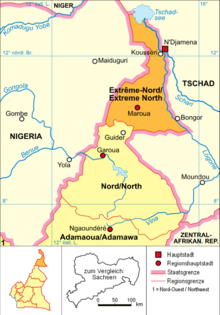Battle of Maroua–Miskin
| Battle of Maroua-Miskin | |||||||
|---|---|---|---|---|---|---|---|
| Part of Adamawa campaign | |||||||
 Political map of Cameroon (Far North Region highlighted) | |||||||
| |||||||
| Belligerents | |||||||
| Fulani | |||||||
| Commanders and leaders | |||||||
|
| Amir Djubayru b. Aadama | ||||||
| Strength | |||||||
| 400 | 1,200 | ||||||
| Casualties and losses | |||||||
| 3 Europeans and 14 Askari | 600-800 | ||||||
The Battle of Maroua–Miskin (18–21 January 1902) was the decisive military confrontation between the Fulani troops of Amir Djubayru b. Aadama and the German Schutztruppe, which solidified the German rule of northern Cameroon.
On the Fulani side, 500 to 800 men were killed. Djubayru fled into the Mandara Mountains at the border area to Nigeria. Head of operations on the German side was Lieutenant Hans Dominik, who after the battle occupied Maroua, the important center of the Fulani, and from there successively forced other regional leaders under German authority. With the military defeat and expulsion of Djubayru as a spiritual and political overlord of the Fulani in Adamawa, the German colonial administration broke the historic ties to the Fulani's center Yola and replaced them with the connection to the seat of the residency Garoua as a new political and economic center.
Sources
- Florian Hoffmann: Okkupation und Militärverwaltung in Kamerun. Etablierung und Institutionalisierung des kolonialen Gewaltmonopols 1891–1914, Göttingen 2007
Coordinates: 5°09′N 12°27′E / 5.15°N 12.45°E